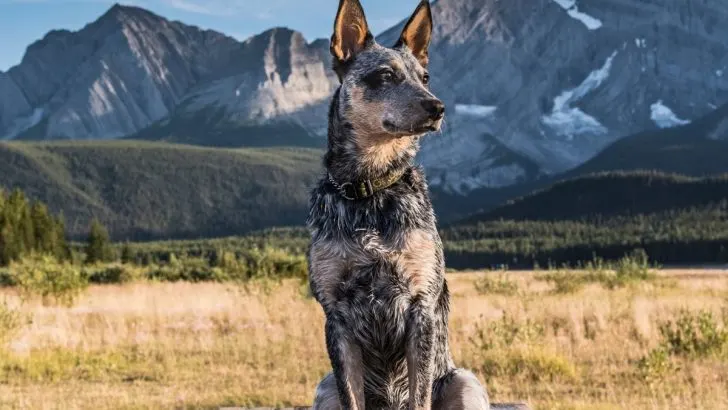The Australian Cattle Dog, also called the Blue, Red, or Queensland Heeler, is a compact yet muscular working dog breed related to Australia’s wild dog, the Dingo.
Standing between 17 to 20 inches at the shoulder, these sturdy herding dogs possess an immense work drive and excel at moving livestock.
They are born with white fur, which turns into blue-gray or red hair and features distinctive mottling or speckling patterns.
ACDs are famously loyal, intelligent, alert, and beloved pets but can quickly become bored and get into mischief if not challenged.
Owners are advised to engage them in work, sport, or regular exercise to keep them mentally and physically fit.
The major kennel club in the United States recognized this breed in 1980, while the United Kingdom did it five years later.
The Complete Blue Heeler Growth Chart
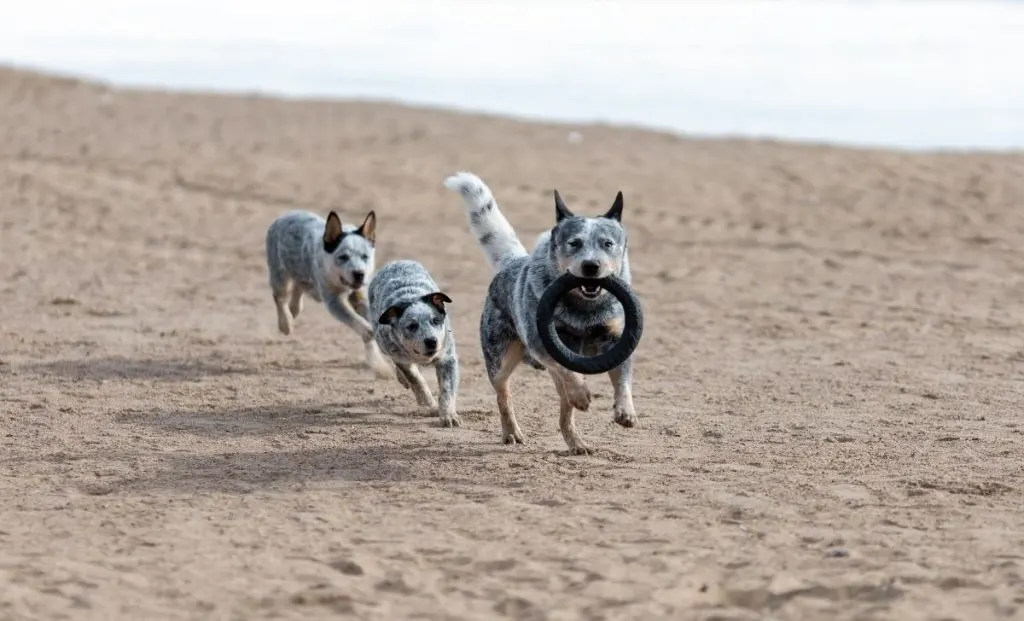
Navigating the maze of puppy growth can be intimidating for new owners, especially with dog breeds like the Blue Heelers, known for their agile and robust disposition.
Observing their development is crucial to ensure they’re on the right track. This article delves deep into Blue Heeler pups’ average weights and heights, delivering standards for each growth stage.
With insights from vets and breed experts, we strive to give you an extensive guide to figuring out the physical progression of these active companions.
Join us as we examine their journey from mischievous pups to agile adults.
Male Blue Heeler Weights And Heights by Age
The following chart includes the average weights and heights of male Blue Heelers from newborn to 3 years of age.
Please note these are only averages.
Always consult your vet if you worry about your Heeler’s growth.
| Age (Months/Years) | Weight (lbs) | Weight (kg) | Height (inches) | Height (cm) |
|---|---|---|---|---|
| 0 | 2-4 | 0.9-1.8 | 2-3 | 5-7.6 |
| 1 | 4-9 | 1.8-4.1 | 4-6 | 10.2-15.2 |
| 2 | 8-18 | 3.6-8.2 | 7-10 | 17.8-25.4 |
| 3 | 18-27 | 8.2-12.2 | 11-13 | 27.9-33.0 |
| 4 | 22-32 | 10.0-14.5 | 13-15 | 33.0-38.1 |
| 5 | 25-35 | 11.3-15.9 | 14-16 | 35.6-40.6 |
| 6 | 28-38 | 12.7-17.2 | 15-17 | 38.1-43.2 |
| 7 | 30-40 | 13.6-18.1 | 15-17 | 38.1-43.2 |
| 8 | 32-42 | 14.5-19.1 | 15-18 | 38.1-45.7 |
| 9 | 35-45 | 15.9-20.4 | 16-18 | 40.6-45.7 |
| 10 | 35-48 | 15.9-21.8 | 16-18 | 40.6-45.7 |
| 11 | 37-50 | 16.8-22.7 | 16-19 | 40.6-48.3 |
| 12 | 40-52 | 18.1-23.6 | 17-19 | 43.2-48.3 |
| 2 years | 45-55 | 20.4-24.9 | 17-20 | 43.2-50.8 |
These estimates can vary based on individual genetics, diet, and environmental factors.
Always consult your veterinarian for the most accurate measurements and advice about your dog’s growth.
Female Blue Heeler Weights And Heights by Age
The following chart includes the average weights and heights of female Blue Heelers from newborn to 3 years of age.
Please note these are only averages.
Always consult your vet if you worry about your Heeler’s growth.
(Months/Years) (lbs) (kg) (inches) (cm)
| Age (Months/Years) | Weight (lbs) | Weight (kg) | Height (inches) | Height (cm) |
|---|---|---|---|---|
| 0 | 2-4 | 0.9-1.8 | 2-3 | 5-7.6 |
| 1 | 4-9 | 1.8-4.1 | 4-6 | 10.2-15.2 |
| 2 | 8-18 | 3.6-8.2 | 7-10 | 17.8-25.4 |
| 3 | 18-27 | 8.2-12.2 | 11-13 | 27.9-33.0 |
| 4 | 22-32 | 10.0-14.5 | 13-15 | 33.0-38.1 |
| 5 | 25-35 | 11.3-15.9 | 14-16 | 35.6-40.6 |
| 6 | 28-38 | 12.7-17.2 | 15-17 | 38.1-43.2 |
| 7 | 30-40 | 13.6-18.1 | 15-17 | 38.1-43.2 |
| 8 | 32-42 | 14.5-19.1 | 15-18 | 38.1-45.7 |
| 9 | 35-45 | 15.9-20.4 | 16-18 | 40.6-45.7 |
| 10 | 35-48 | 15.9-21.8 | 16-18 | 40.6-45.7 |
| 11 | 37-50 | 16.8-22.7 | 16-19 | 40.6-48.3 |
| 12 | 40-52 | 18.1-23.6 | 17-19 | 43.2-48.3 |
| 2 years | 45-55 | 20.4-24.9 | 17-20 | 43.2-50.8 |
Milestones Of The Blue Heeler Growth Chart

Let’s go through the prevailing and significant milestones of the Blue Heeler growth chart.
A smaller dog like a Boston Terrier will mature more quickly than a Doberman, while a Rat Terrier will develop more rapidly than a German Shepherd Dog.
Size plays a vital part in growth. A Blue Heeler will, therefore, grow at a pace comparable to that of an Australian Kelpie.
Even though they don’t seem to retain anything in common, a Frenchie will grow at the same speed as a mini-sized Poodle.
Two-week-old Blue Heeler
Since they are born, Blue Heeler pups are dependent on their mom. During this time, they are too young to do anything alone because the pups are born without teeth and the ability to see and hear.
Nonetheless, they can feel and taste right after their birth. Yet, the only thing they can and want to do is to cuddle up to their mom for milk and warmth.
Puppies will spend most of their awake hours nursing their mommy and the rest of the time sleeping in close proximity to her.
The pups are still too young to walk because, at this stage, their muscle mass has not developed yet.
12-week-old Blue Heeler
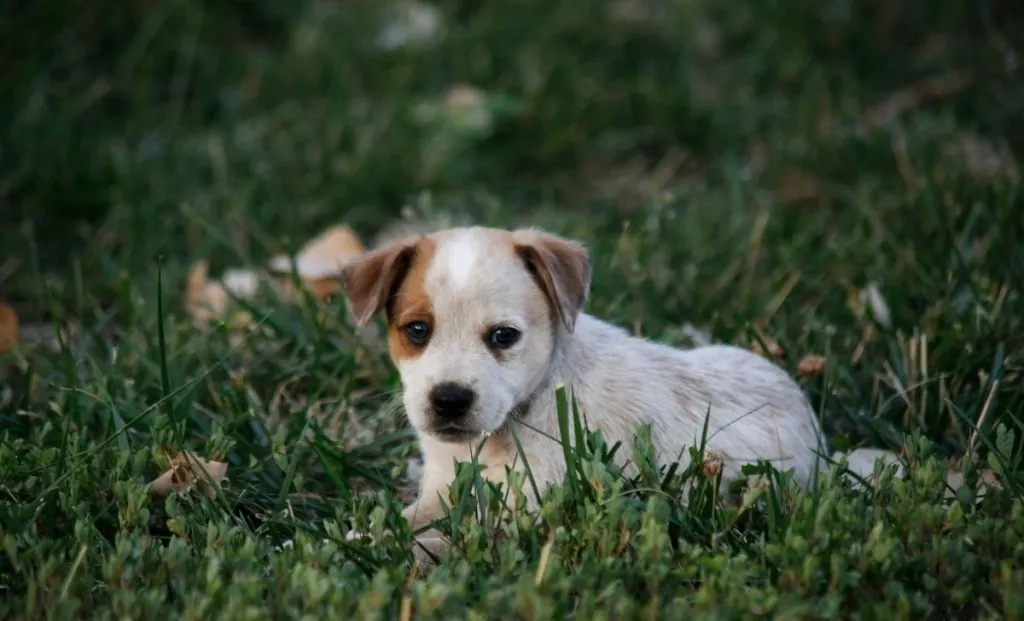
A Blue Heeler pup at three weeks old should have his eyes wide open, and his hearing should begin to evolve.
At this period, the Blue Heeler puppy is ready to cause small amounts of mischief because he can now stand, run, and bark as his muscles and joints develop further.
Thankfully, we can easily forgive all the problems they cause because their tail starts wagging at this stage as well, and they simply become too cute to scold.
The pup will start to grow his teeth as well. The interaction with his littermates develops further as the puppy grows more aware of his surroundings and environment thanks to the advancement of vision.
At this stage, your Blue Heeler will be ready to transition to puppy meals, which often come in the shape of a pate, after the first few weeks of age.
Pups will also start to attain control over their bladders at this time, regardless of whether they are a Blue Heeler or any other dog breed.
The puppies playing a lot will help with their coordination.
This is a terrific age to begin early socialization and basic obedience training with these dogs. This breed is smart enough to understand some basic instructions, but it does not yet count on these puppies to obey commands.
4 To 9 Months Old Blue Heeler
Your Blue Heeler will start teething at approximately about this age. So, the hell gates open, and the result is that the pup desires to chew everything he can see and touch.
If you want to continue owning nice stuff, you have to stop unwanted chewing immediately and redirect the behavior to a toy or something else the dog can chew.
The longer you wait to implement boundaries with your puppy, however cute he might seem at this time, the less likely you will succeed.
Also, this is the ideal time to form strong bonds with pups. You can do so by training and socializing your puppy because your Blue Heeler pup should have finished all of the vaccinations by now.
The probability of success grows as you begin socializing and training your dog earlier.
Spending quality time with your canine is the singular best way to develop the extraordinary connection that the two of you need.
Keep up with your dog’s training. Spend a lot of time playing, having fun, and exercising as well.
This is an ideal choice for socializing and improving bone and muscular health.
Also, a free training tip – play is the best way to form a connection with your dog. It is going to be the base for training, your bond, and every other important aspect of coexisting with your dog.
10 To 18 Months Old Blue Heeler
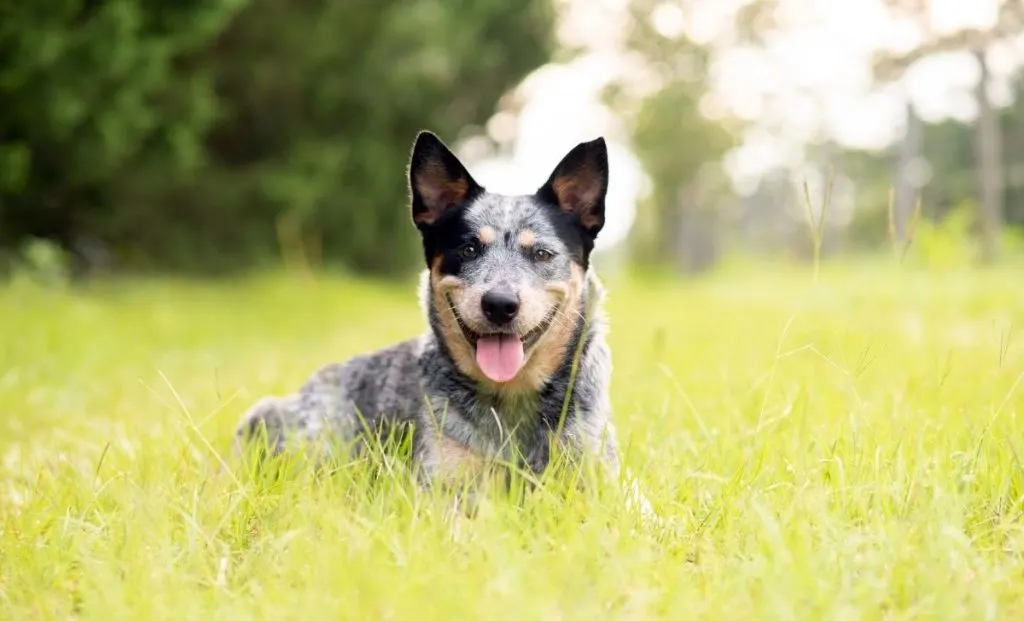
Your Blue Heeler puppy will reach sexual maturity at this period. You will probably notice some hormonal differences in your dog at this period.
I feel obliged to mention this one more time; not all dogs experience changes simultaneously. Some dog breeds may take a longer period of time to reach full maturity.
Twice a year, a female Blue Heeler can get pregnant. This implies that they are able to have two litters every year if they aren’t spayed, but that is the standard for every dog breed.
Males often take longer to arrive at sexual maturity.
18 Month And Older Blue Heeler
Between the years of one and two, the Blue Heeler is considered to be fully developed and matured.
They will still enjoy spending time with their humans and should settle down into a routine, even if they now start behaving like a typical Blue Heeler.
Minor differences are to be anticipated during the adult era. Not all dogs are the same, and their temperaments often differ. Once your pup is old enough, things will likely continue as they are because their personalities are fully developed.
Contact your area veterinarian immediately if you have a surprising weight gain or decline. A health issue with your canine may need to be examined.
Blue Heeler Lifespan
The usual lifespan of a Blue Heeler is between 13 and 15 years.
Providing the dogs with proper nutrition, exercise, and regular checkups ensures they live a long and healthy life.
It is essential to ensure your Blue Heeler is a healthy weight for its size to prevent any potential health issues like hip dysplasia.
How Large Will My Blue Heeler Puppy Get As An Adult?
Blue Heelers are medium-sized when wholly matured. Generally, males weigh between 35-50 pounds, and ladies weigh anywhere between 30 to 45 pounds. In height, they stand from 17 to 20 inches at the shoulder.
When Will My Australian Cattle Dog Cease Developing?
Most Australian Cattle Dogs achieve their maximum height by 12-15 months of age, but they might resume filling out and acquiring muscle and weight until they are approximately two years old. It can deviate from one individual to another.
They generally follow a typical development pattern comparable to other medium-sized breeds. They might seem thin during puppyhood, but they’ll round out as they approach adulthood.
Is A Quick Weight Increase Ordinary For My Australian Cattle Dog Puppy?
Fast growth can happen, particularly during 2-6 months of age. Regardless, it’s crucial to ensure they will not be overweight.
Routine checkups and observing their body condition are essential.
TIP: The ribs must be noticeable with a tiny amount of fat covering, and when looked at from above, there must be an observable waist.
How And What Should I Feed My Developing Australian Cattle Dog Puppy?
Feeding your puppy thrice daily is suggested during the first six months. After that, you can transition to two feeds daily as they reach adulthood.
A high-quality dog food developed for active breeds or medium-sized puppies is perfect. It should be balanced, with sufficient protein, fatty acids, and essential nutrients to help their development and energy levels.
Blue Heeler Puppy Tips
While these pups are active and require routine exercise, however over-exertion should be avoided in maturing puppies. Brief, frequent play sessions and walks are perfect, slowly increasing as they age.
Basic obedience can start earlier, but for high-impact training like agility, waiting until they are at least 12-18 months old is helpful to save their formulating joints.
Herding instincts can display as early as 6-8 weeks, with puppies trying to herd toys, other animals, or even people. This behavior tends to strengthen as they mature.
This also means the pups start nipping at the heels of people and other animals.
That is an instinctual herding trait. While it’s natural, dealing with it through training, diverting the behavior to toys, or discouraging it from preventing problems as they develop is essential.
Crate train your dog. Crate training offers a safe space for your pup, helping with house training and deterring destructive behaviors, especially during their active development phases.
Ensure the dogs joints and bones are healthy during development, provide a balanced diet, avoid over-exercising, and be cautious with high-impact activities.
Regular vet checkups and, if necessary, joint supplements can further support joint health.
To Sum It All Up
This gorgeous working dog is a feisty little ball of happiness, even though it is not a good fit for pet parents without previous experience.
As Blue Heelers mature, they become loving, eagerly participating in activities and forging strong bonds with their human counterparts.
They are typically a healthy dog breed with a lifespan of 13 to 15 years. Providing these pups with proper care, including regular check-ups and exercise, ensures they lead long and healthy lives.
Whether you’re a seasoned Blue Heeler owner or embarking on this adventure for the first time, I hope this article can be your heartwarming guide that celebrates the joys of raising and nurturing these intelligent and spirited dogs.
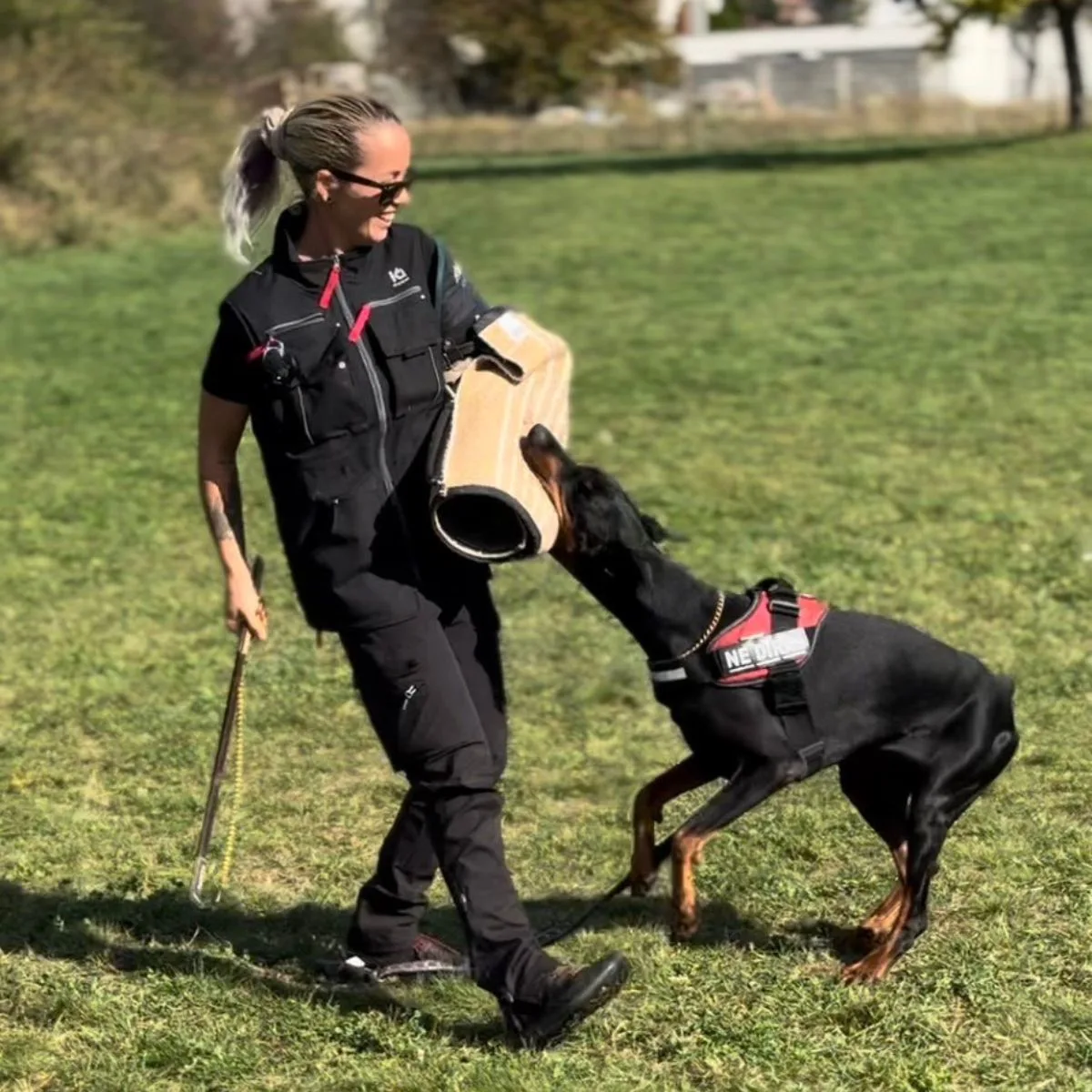
Nandina has been a lifelong dog owner and enthusiast. She shared her home with multiple breeds, including Giant Schnauzers, Cane Corsos, and Huskies. Currently, she is raising a three-year-old rescue and a working-line German Shepherd puppy.
Actively engaged in IGP dog sports for two years, Nandina is a certified instructor for basic obedience and socialization. She works as a trainer in her local dog sports club, and in her spare time, she handicrafts biothane gear for dogs.
